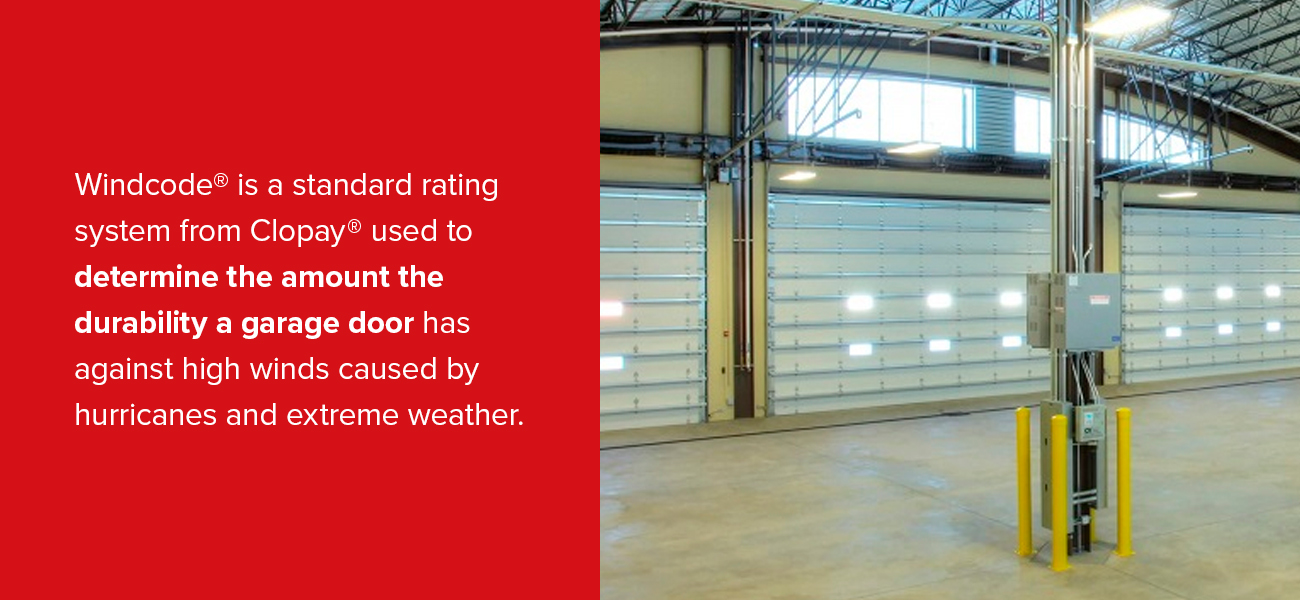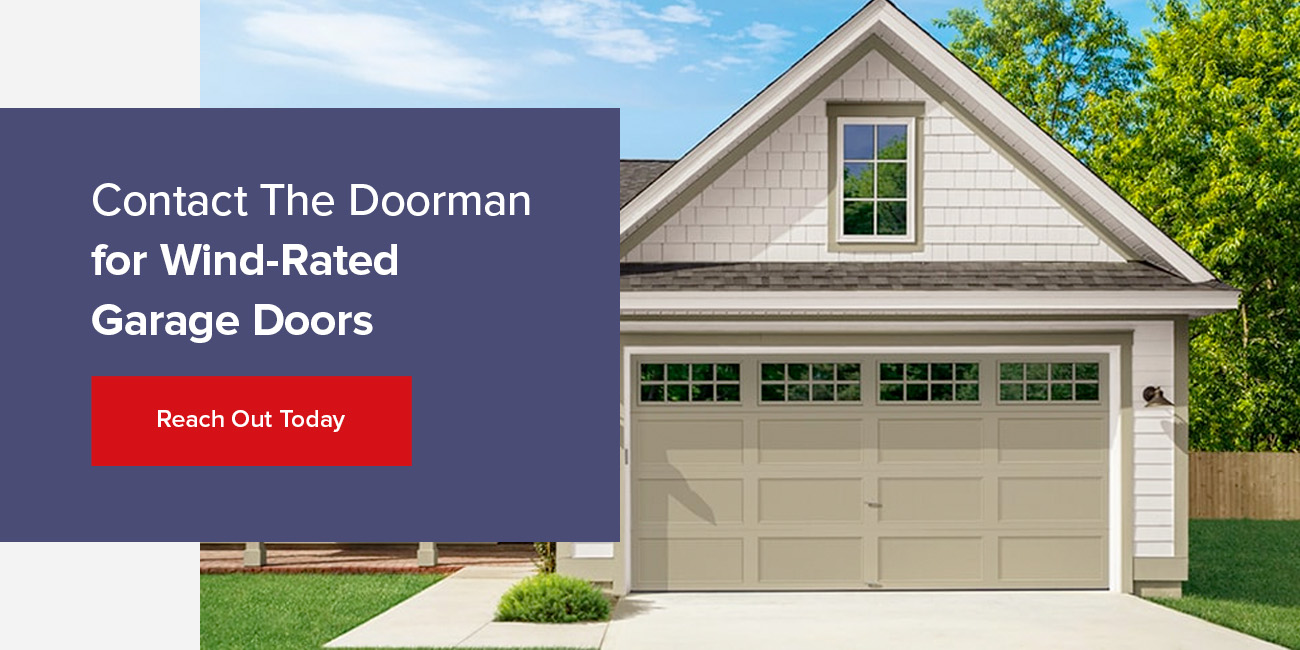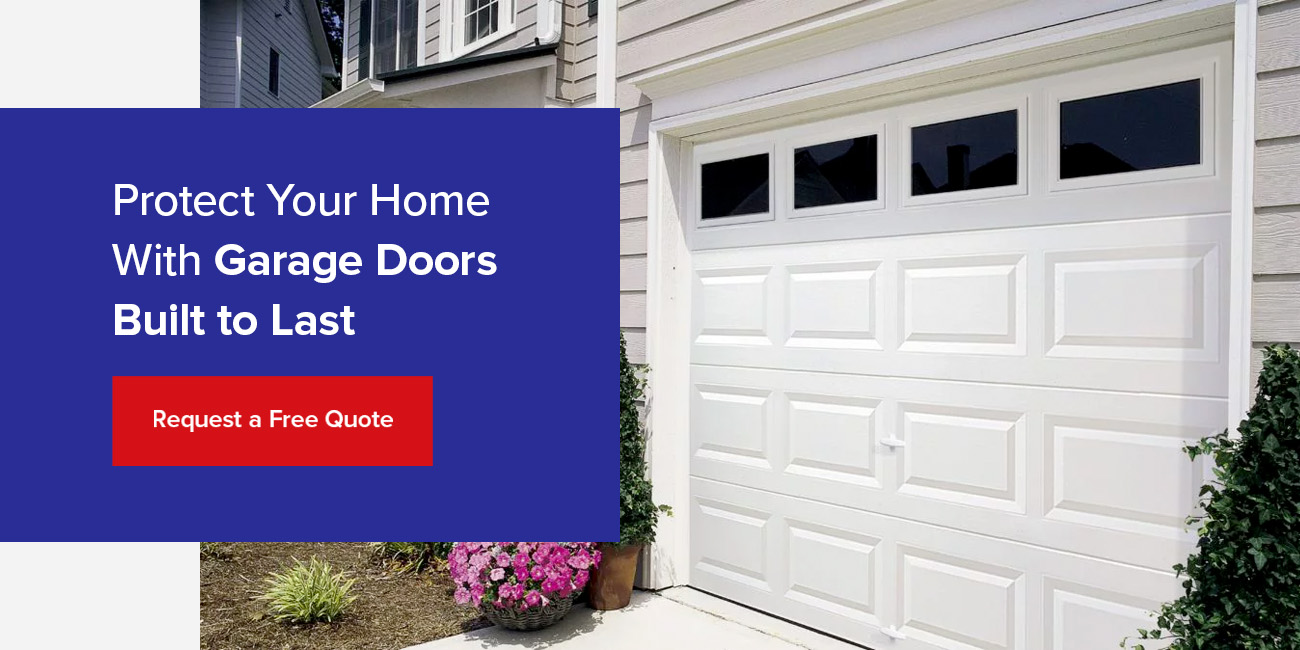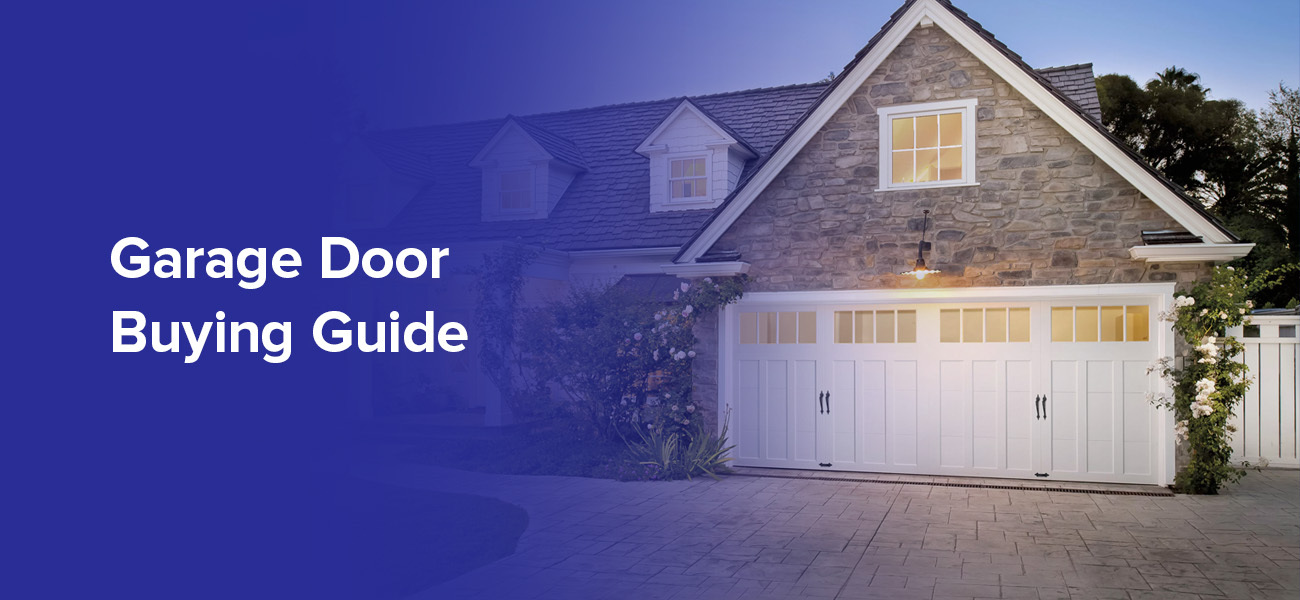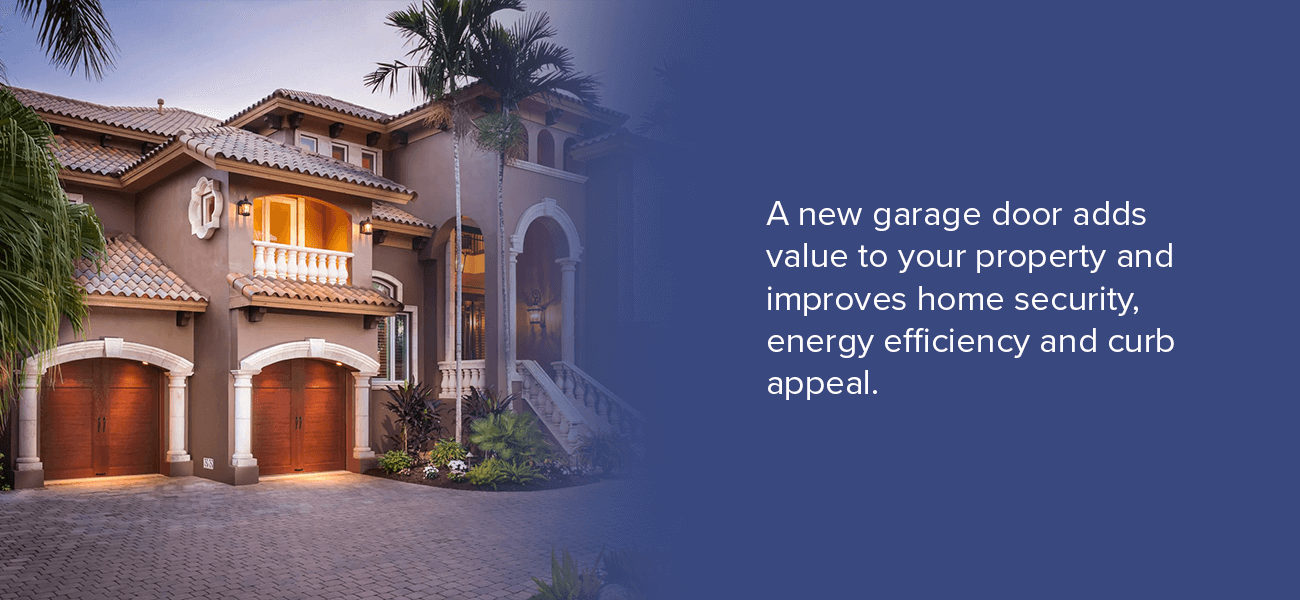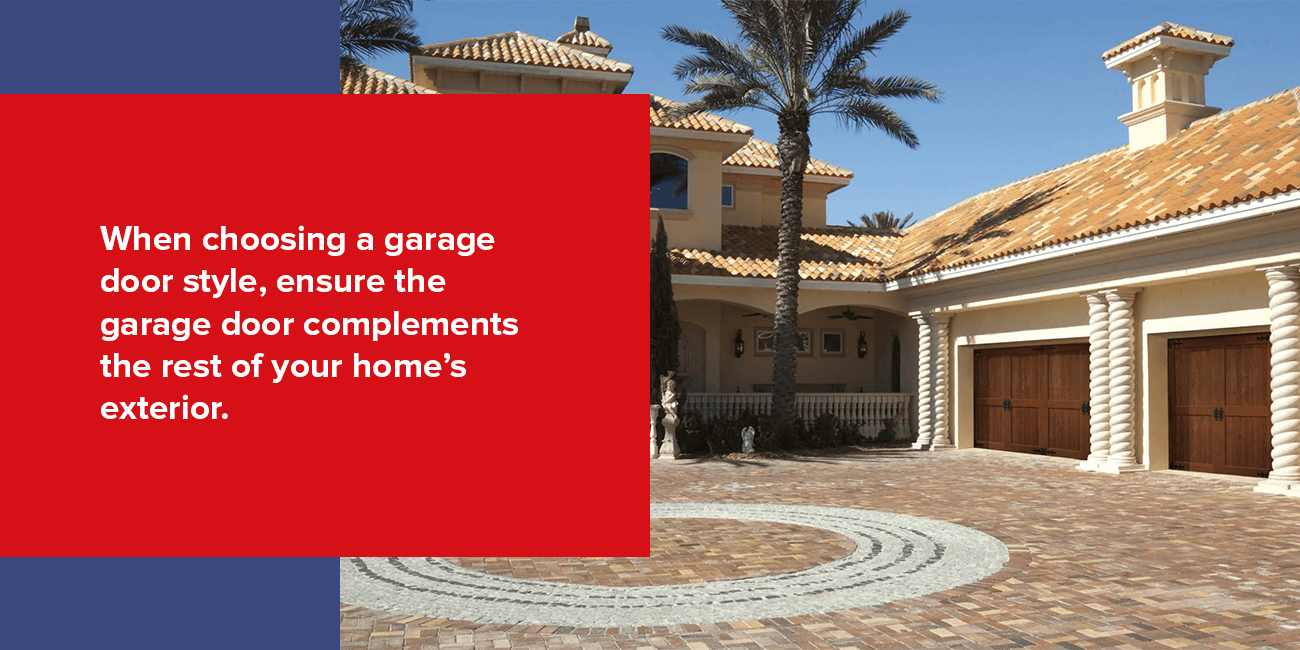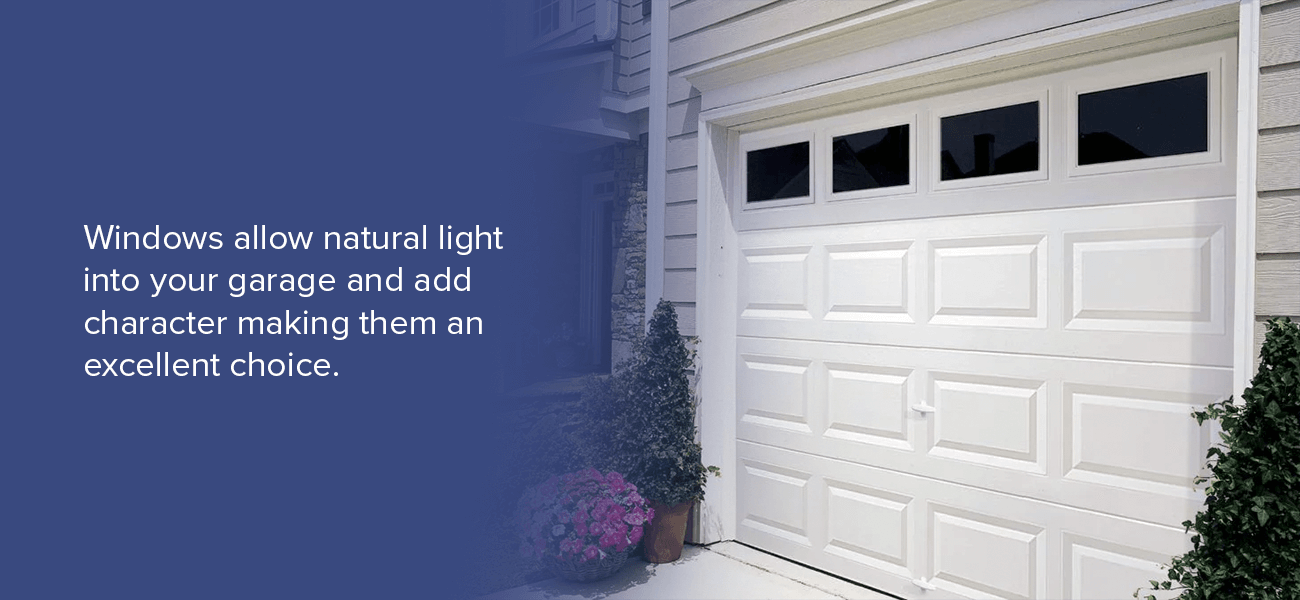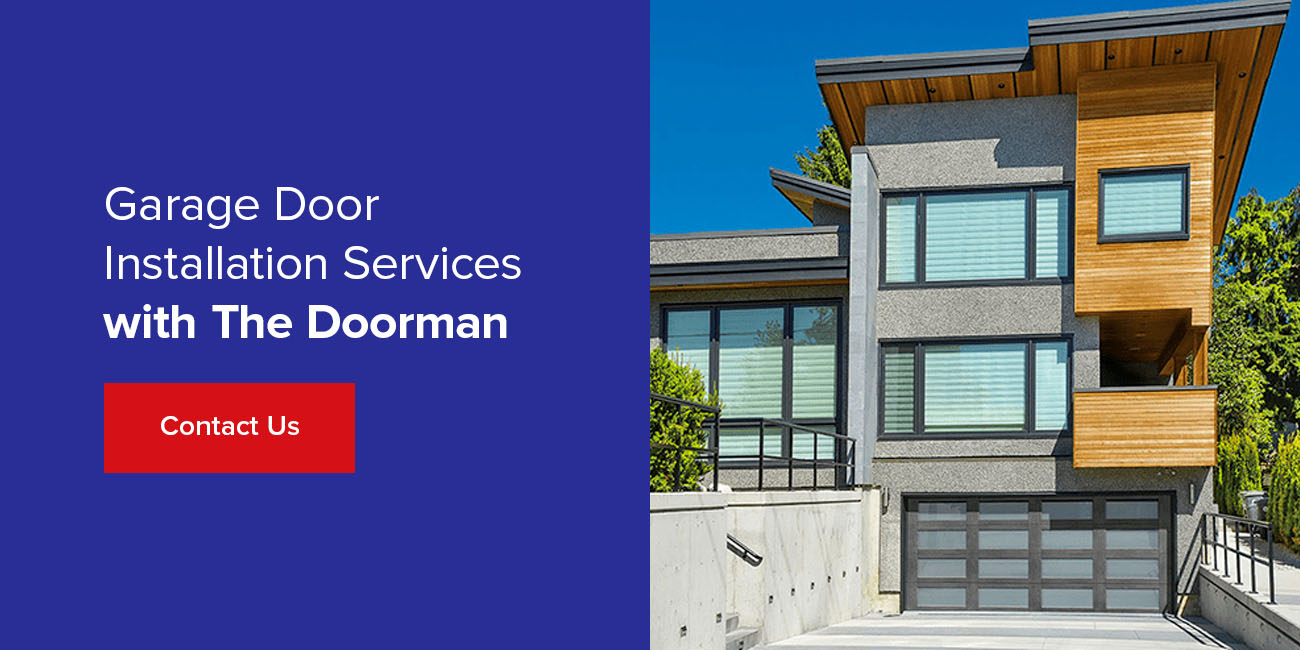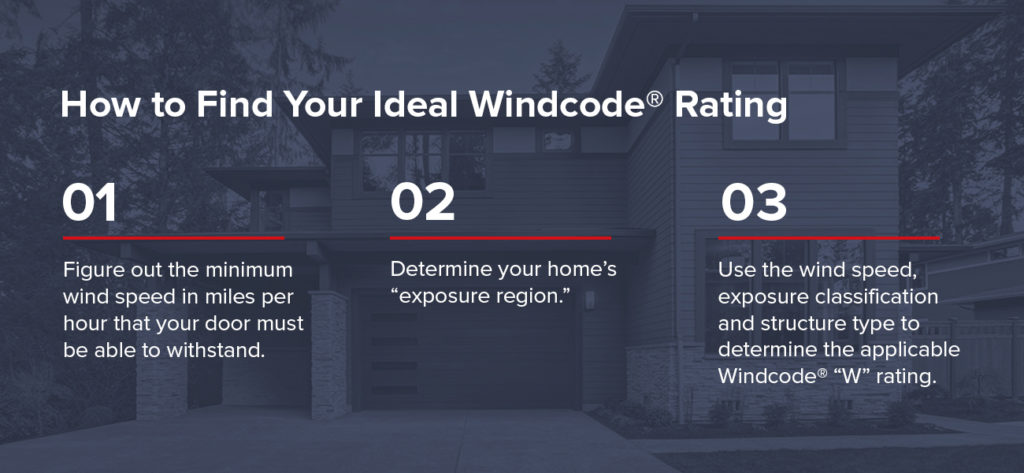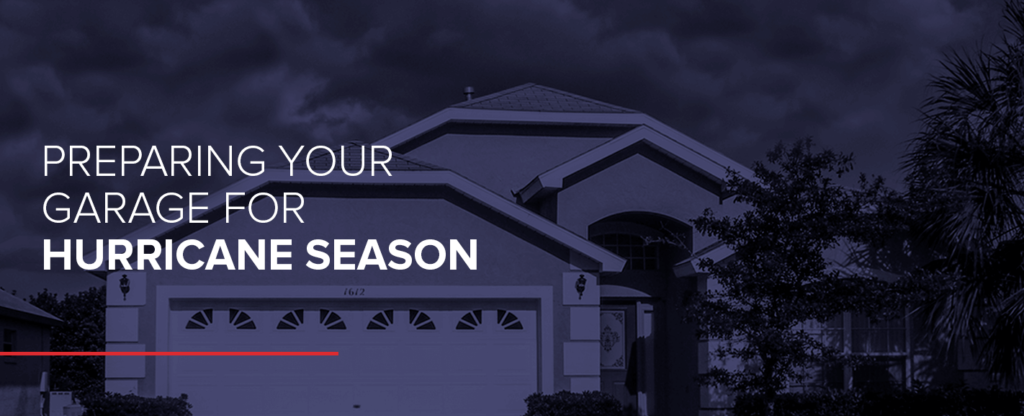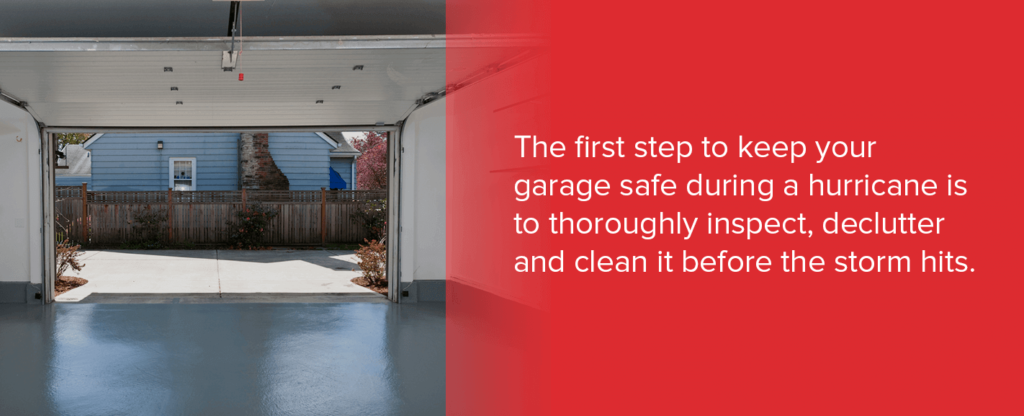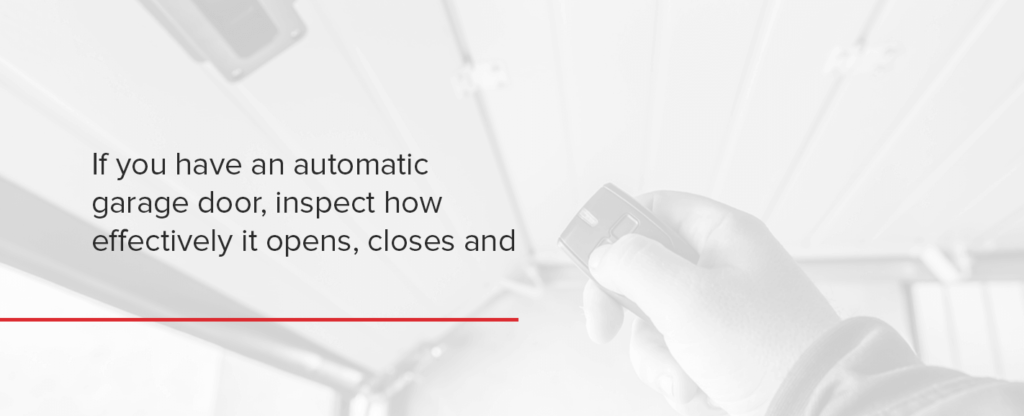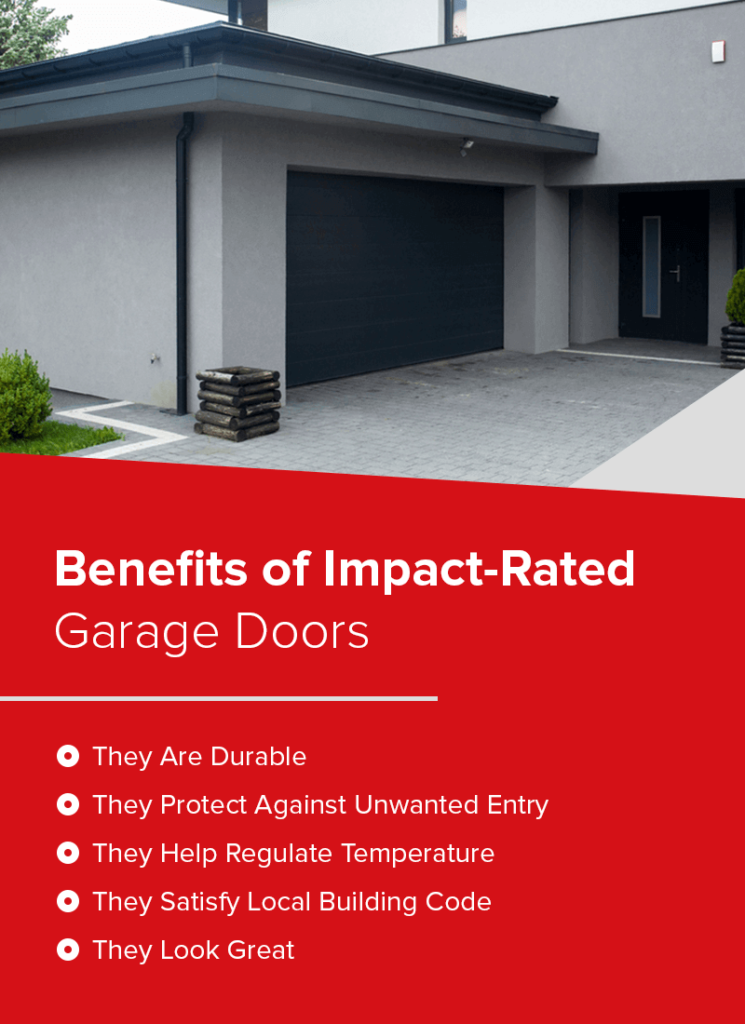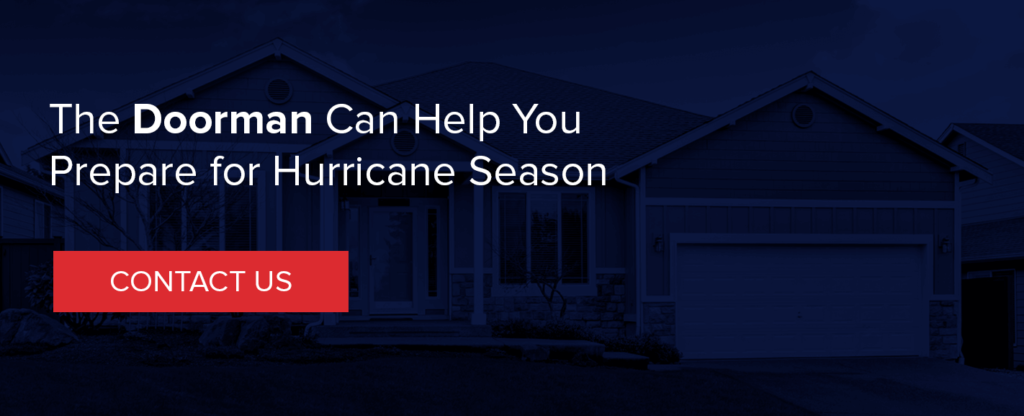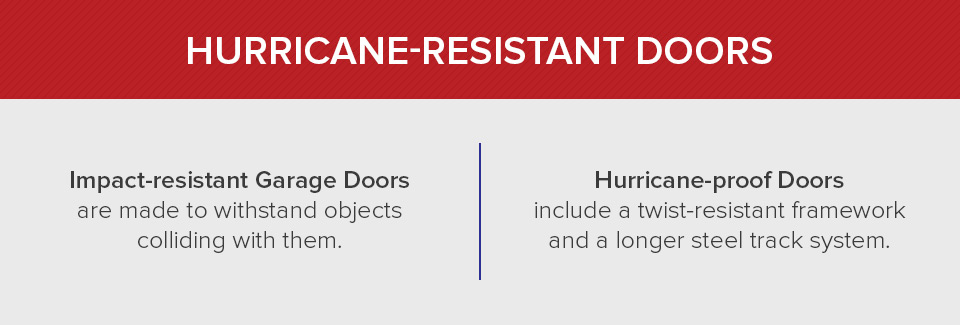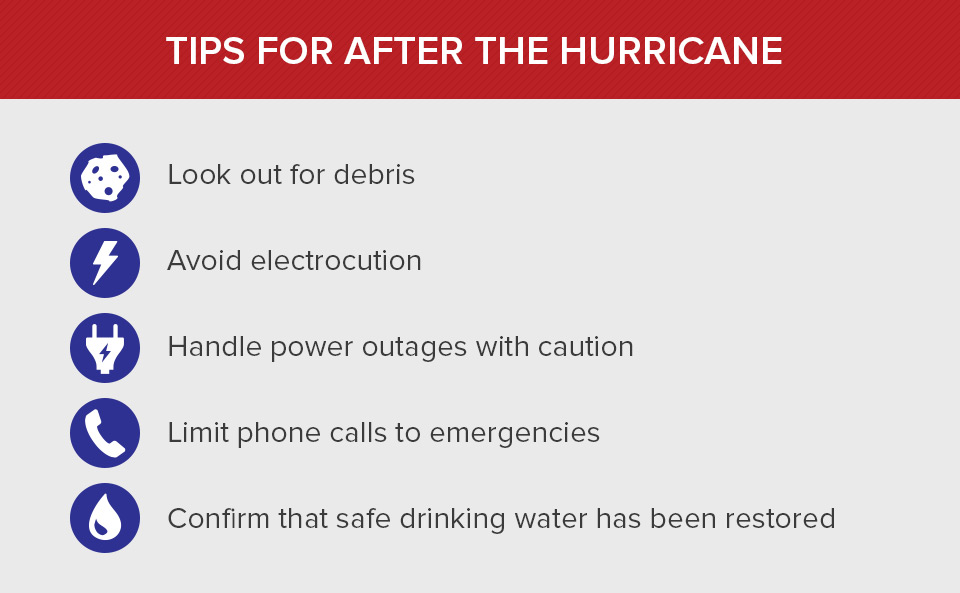Why Is It Important to Follow WindCode® Rating Regulations in Florida?
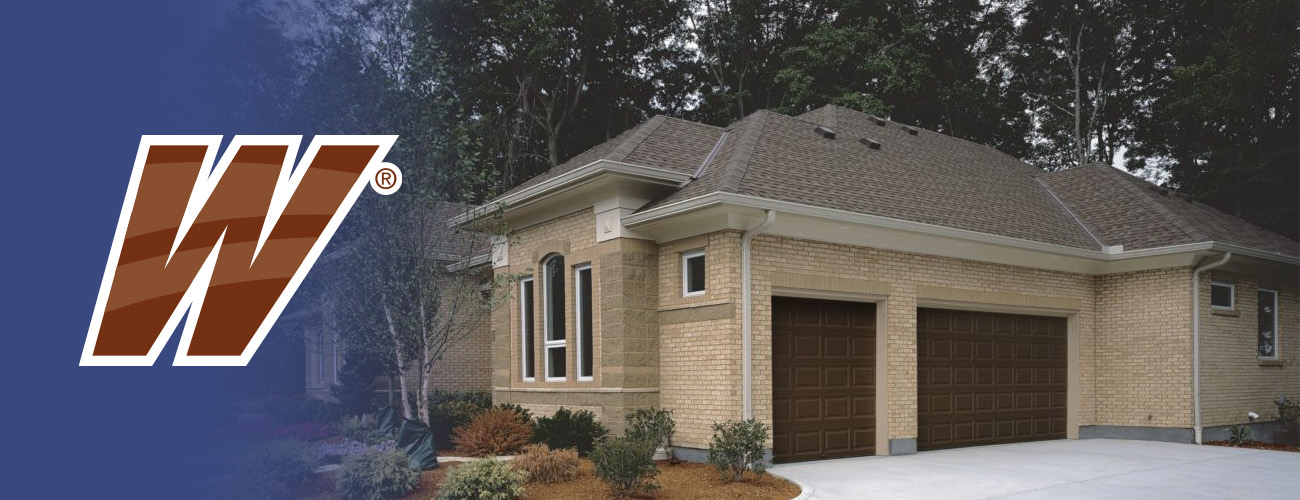
Many building codes require garages to meet certain standards, including a specific wind rating. A wind rating identifies a structure and its components’ ability to resist wind in weather conditions like tropical storms, tornados and hurricanes.
The WindCode® rating system uses a scale of W1 to W9, with the highest number offering the most resistance to wind.
Browse our Hurricane-Rated Garage Doors
Why Hurricane-Rated Garage Doors Are Important
A garage door with the proper WindCode rating is critical to your peace of mind knowing you have the best protection for your family and home. Factors including the type of structure, height, exposure rating and the area where you live determine which level of wind protection you should have for your garage door.
Today’s advanced testing of garage doors factors in the high speed and swirling motion of winds during storms and hurricanes. The testing process mimics positive pressure when the wind blows against your garage door. It also tests negative pressure when the wind pulls your garage door.
The amount of positive and negative pressure your garage door can withstand from wind and wind-borne debris is measured in pounds per square foot (PSF). The higher the number, the more weight a door can handle.
Are WindCode Ratings Important in Florida?
You must follow WindCode rating regulations when living on the coast or around areas with significant hurricane seasons. The ratings signify the strength of your garage door against winds ranging from 85 to 150 miles per hour.
The correct wind rating protects the structural integrity of your garage and your home. Otherwise, a pressure buildup could lead to hazards like wall and roof damage.
You can check the side of your garage door for a label or sticker indicating a WindCode rating and positive and negative PSF values. If you need help locating this information, you can contact your local door company to inspect your door and provide guidance as needed.
Benefits of WindCode-Rated Garage Doors
Beyond safety, additional advantages of having a hurricane-resistant door include:
- Noise reduction: These garage doors can keep you from hearing noisy disturbances, like traffic.
- Better insulation: The doors keep the wind out for a more balanced temperature indoors.
- Lower insurance rates: Storm-protected doors appeal to many insurance companies, with some offering discounts on premiums following installation.
Contact The Doorman for More Information
The Doorman is your source for garage door answers and solutions in and around southeast Florida. If you need a garage door inspection, service or replacement, contact our team today!
What Does It Mean If a Garage Door Has a High Windcode® Rating?
Windcode® ratings indicate your garage door’s ability to withstand intense storms or hurricanes. A garage door with a high Windcode® rating can prevent high winds from breaching your property, protecting it from potential damage. Building codes in hurricane-prone states like Florida require structures to withstand extreme weather events, which is why most garage doors are built to be wind-resistant.
Understanding Windcode® Ratings for Garage Doors
Windcode® is a standard rating system from Clopay® used to determine the amount the durability a garage door has against high winds caused by hurricanes and extreme weather. The rating considers factors such as building codes, roof height and exposure to rank your garage door. A Windcode® rating specifies the pressure and wind speed your garage door can handle with levels ranging from W-1 to W-9.
Depending on where you live and the building, your Windcode® will need to be higher or lower. For instance, areas that are more vulnerable to having windows and doors broken by debris carried by the wind during a hurricane will require a higher Windcode® rating. Higher ratings indicate that the garage door is built to resist stronger winds. You will find the rating on a large sticker or label on your garage door.
Pounds Per Square Foot (PSF)
When your garage door fails, that can cause a build-up of internal pressure in your property. This can result in damage to walls, windows or roofs when combined with the wind that enters your interior structure. Pounds per square foot (PSF) measures the pressure a garage door can endure from wind or wind-borne debris. A rating has positive and negative PSF. Positive indicates wind blowing against your property which will cause your garage door to cave in, and negative indicates the amount of wind trying to suck or pull the garage door off your structure.
Should Your Garage Door Have a High Windcode®?
Having a wind-resistant garage door is always a safe option. When you live in hurricane-prone areas, it is especially necessary to have a garage door with a high Windcode®. If a garage door fails when high winds and extreme weather occur, your property will be exposed to the elements. You can go from having a few damaged items to having structural damage to your home. A wind-rated garage door helps to protect your garage and the rest of your home.
Contact The Doorman for a Wind-Rated Garage Door Installation
We proudly offer Clopay Windcode® garage doors and quality installations to residential and commercial properties in South Florida. Clopay Windcode® garage doors adhere to building code requirements and are designed to withstand extreme weather events with a built-in reinforcement system.
Contact us online to schedule an appointment today!
How Much Wind Can a Garage Door Withstand?
Whether you move into a new home or want to invest in a replacement for your existing home, it’s necessary to learn how much wind your garage door can withstand. Ensuring your doors have the correct WindCode® rating for your area can help keep your family, home and belongings safe.
Why Is It Important to Know Your Garage Door’s Wind Load?
Your garage door separates your home and the elements. Garage doors act as physical barriers against weather and burglars and help regulate your interior temperature by keeping hot or cold air out so you can save money over time.
Without the right level of wind resistance, a garage door can sustain significant damage. A garage door that fits your home’s wind load offers:
- Impact resistance: A suitable, wind-rated garage door has a strong resistance to debris picked up by the wind, preventing dents and damage.
- Ideal window pressure: The correct wind resistance can prevent internal pressure from damaging windows, keeping your home safer.
- Secure tracks and structure: Proper resistance can bar strong winds from opening your garage door and keep its components securely attached, maintaining excellent structural integrity.
Wind-Rated Garage Doors Explained
Generally, standard garage doors withstand winds around 20 miles per hour (mph). However, areas prone to strong wind, like Florida, require homeowners to meet local requirements for hurricane resistance. Some exposure zones need wind resistance for winds faster than 150 mph to protect structures from Category 5 hurricanes.
Garage doors built with protection for storms and hurricanes have a WindCode rating of W1 through W9, with higher numbers indicating more resistance.
How to Determine Your WindCode® Rating
To see your garage door’s score, you can look for a label on an orange, yellow or white sticker along the inside of the door. If you need help determining what wind load your garage door needs to handle, you can use a WindCode calculator designed for residential homes in Florida.
You can also have a specialized technician evaluate your garage door’s “W” score, explain what level of resistance you need and indicate whether you need to invest in repairs, service or replacement to keep you and your home safe.
Contact The Doorman for Wind-Rated Garage Doors
As a Clopay® Authorized Dealer™ in Southeast Florida, The Doorman can help you ensure your garage door meets local building codes for hurricane resistance. To request an installation, repair or service, reach out to us today!
What Is a WindCode® Rating?
Garage doors play a crucial role in protecting your home all year round. In Florida, they can help keep strong winds from entering your house, preventing a buildup of pressure that can cause window or roof damage.
To help keep you and your family as safe as possible during a weather event, such as a tropical storm or hurricane, the Florida Building Commission requires all garage doors sold in Florida to meet the local regulations and standards for hurricane resistance. Investing in garage doors with the appropriate WindCode® rating can help you save money and experience peace of mind.
What Determines the WindCode Rating for Garage Doors?
The WindCode rating for garage doors assigns a “W” score from W1 to W9, with a higher number indicating stronger wind resistance. These factors determine the score:
- Exposure zone: Homes in populated or wooded areas — Exposure B regions — and homes in open spaces — Exposure C regions — require different levels of wind resistance based on wind pressure and exposure ratings.
- Home orientation and structural type: Your home’s orientation and structure — one-story or two-story — can affect the amount of wind load pressure your garage doors experience.
- Amount of wind a garage door can withstand: Your door must be able to resist a specific wind speed determined by your location, home height and garage door size.
Tips for Finding a Hurricane-Rated Garage Door
A few strategies can make staying safe during high wind conditions easier. Whether you’re moving into a new home or need to replace your existing garage doors, follow these tips for finding doors with a suitable WindCode rating:
- Research your area: Your local officials’ website can supply updated and specific information about the building codes you must follow.
- Check your current garage door: A technician can perform an on-site inspection to evaluate whether your garage doors match your area’s “W” code.
- Learn about the benefits of a storm-ready door: Clopay® storm-ready doors are America’s favorite garage doors because they provide quality, convenience and peace of mind.
Protect Your Home With Garage Doors Built to Last
Does your home require a garage door with hurricane resistance? The Doorman provides solutions such as installations, repairs and services to homeowners in Southeast Florida. We’re a Clopay Authorized Dealer™ with reliable, friendly and fast service. Our experts can help you choose a garage door that withstands high winds and other concerns. Fill out a contact form online to request a free quote today!
Garage Door Buying Guide
Your garage door is one of the most noticeable parts of your home’s exterior. Thus, it significantly impacts your home’s curb appeal and security. Purchasing or replacing a garage door requires careful thinking and planning. If you are looking for garage door buying guidance, read this guide for our expert tips.
Why Replace Your Garage Door
Installing a high-quality and modern garage door offers many benefits for your home. A new garage door adds value to your property and improves home security, energy efficiency and curb appeal. Most newer garage doors come with added features that allow you to access, monitor and control your home with your smart devices.
Instead of relying on a few remote controls, you can conveniently open and close your garage with a mobile phone, tablet or laptop anywhere in the world — all you need is an internet connection. If your children left their keys inside, you can let them in without driving home to grant them access. Similarly, you can open the door for couriers to safely place packages in your garage and close it when they leave while monitoring the activity on your smartphone.
Altogether, replacing your garage door with a new model when it no longer works can help you increase your home’s security and create a more convenient experience for you and your family.
When Is the Best Time to Buy Garage Doors?
In some ways, the best time to buy garage doors depends on where you live. If you live in a tropical region like Florida, replacing your garage door before hurricane season prepares your home for tropical storms. As hurricane season runs from June 1 to November 30, spring is optimal for installing a new garage door. If it is a mild winter, you can replace your garage door during those months.
What to Look for When Buying a New Garage Door
Here are the vital factors to consider when buying a new garage door:
1. Security
As the largest entrance to your home, a secure garage door protects your loved ones and belongings from danger or theft. New garage doors have advanced security options through smartphone compatibility. You can open and close the door using an app connecting to your garage door or check its status anywhere.
2. Function
Although the traditional purpose for garages is vehicle storage, many homeowners have alternative intentions for their garage space. Some of these uses include:
- Children’s play area
- Art studio
- Laundry room
- Workshop
- Entertainment area
Determining your garage space function will influence what kind of garage door might suit your needs best. For example, vehicle storage spaces or laundry rooms may require less insulation. In contrast, insulation is necessary for art studios, entertainment areas or any purpose involving extended time spent in the garage. Likewise, a children’s play area will need advanced safety features.
3. Insulation
Insulation has emerged as a crucial addition to garage doors. Insulation can increase energy efficiency in both harsh and moderate climates. The insulation traps heat inside the garage in harsher climates and keeps cool air inside during tropical climates. This helps you decrease your air conditioning reliance.
There are generally three options for garage door insulation — single-layer, double-layer and triple-layer.
4. Hurricane Protection
If you live in a South Atlantic state, hurricane protection is necessary. Wind-resistant garage doors are pressure-rated to withstand high winds and flying debris during hurricanes, tornadoes and other storms. Find your area’s recommended garage door pressure rating and install a door that meets that standard.
How to Choose the Right Garage Door
Besides noting what to look for when buying of garage door, you may also wonder what type of garage door you should buy. Here are six garage door buying tips to consider when purchasing a new garage door for your home.
1. Budget
Garage door costs vary according to several factors, including:
- Material
- Insulation rating
- Style
- Hardware
- Number of doors
- Size
As you try to find a garage door within your budget, consider which variables are most important. Weigh the aesthetic against practical considerations, like insulation and durability.
2. Material
The material you choose for your garage door influences aesthetic, maintenance and durability. The primary materials for garage doors include:
- Aluminum and glass: Aluminum and glass doors have simple architectural lines, providing a modern aesthetic with plenty of natural light. They are also lightweight, durable, energy-efficient, resistant to corrosion, require less maintenance and have strong insulators.
- Steel: Steel is cost-effective, durable and easy to maintain. Steel garage doors can withstand any climate and resist warping or cracking from moisture. They also provide a modern aesthetic with many customization options.
- Wood: Wooden garage doors provide a natural aesthetic and endless customization options. They are durable against impact, have high inherent R-values for insulation and are eco-friendly. With proper preventive measures, a wooden garage door can last decades.
- Composite: Composite garage door material consists of recycled wood and plastic fibers. This material is more affordable and lightweight than wooden garage doors. Composite garage doors mimic wooden garage doors’ natural aesthetic and have higher resistance to mold and rots.
3. Style
When choosing a garage door style, ensure the garage door complements the rest of your home’s exterior. The main style categories for garage doors include:
- Carriage house
- Contemporary
- Flush
- Long-raised
- Short-raised
4. Finish or Color
The garage door finish and color can add a personal touch to your door and increases curb appeal. You can apply a wood-grain finish to a steel door, opt for a neutral shade or choose a solid hue rich in color, like burgundy or dark green. The finish you choose could also depend on the door’s material. For example, if you select a wooden door, you may need a weather-resistant finish to protect the wood against excess moisture.
There are other essential things to consider with finish or color:
- The color and finish should blend well with the rest of your home’s color and exterior style.
- Neutral colors like black, gray, tan, brown or white blend well with almost any exterior style, so they are often safe.
- Darker shades tend to fade faster in direct sunlight. You may opt for a lighter shade if your garage door receives plenty of sunlight.
5. Windows
Windows allow natural light into your garage and add character making them an excellent choice. There are many options to choose from, including:
- A row of square windows
- Arched or cathedral-style windows
- Glass grid windows
- Rectangular columns
You can also find impact-resistant glass if you live in high-wind areas or obstructive glaze to maintain privacy while letting in natural light.
6. Size
To determine the garage door size you need, make a few measurements on your existing garage door. These measurements include the rough opening, left and right side room, headroom and backroom. Once you have these measurements, take them to your garage door dealer and they will help you find the right garage door size.
Where to Buy a New Garage Door
Choosing a garage door is crucial, so it helps if you partner with a trusted vendor. The Doorman of Southeast Florida has a wide range of residential garage doors to choose from, including doors impact-rated to withstand the annual hurricane season.
We only provide top-quality garage door installation and repair services at The Doorman of Southeast Florida. Contact us today for a free quote or schedule your $39.95 garage door tune-up!
How to Find Your Garage Door Windcode® Rating
South Florida is known for its tropical climate, beautiful beaches and active hurricane season. Some of the more notorious and devastating hurricanes that have struck the region over the years include Andrew in 1992, Katrina in 2005 and most recently, Hurricane Irma in 2017. Property damage estimates from Irma ranged from $42.5 billion to $65 billion.
Because of the persistent threat of hurricanes, Florida building code garage door requirements ensure that all doors installed in the region comply with specific regulations and standards regarding hurricane resistance. The Windcode® rating system has been developed to determine the wind resistance requirements and capabilities of a structure and its components.
If you live in an area with the potential for hurricanes or high winds — like Florida — knowing that Windcode® rating is essential to keep your garage door stable. However, it can be challenging actually figuring out how to find the Windcode® rating for a garage door.
To figure it out, you’ll need some basic information.
View Windcode-Rated Garage Door Styles
What Is a Windcode® Rating?
A Windcode® rating is a system used for determining the strength and durability of a garage door against high winds produced by a tropical storm or hurricane. The Clopay® rating system ranks garage doors on a scale from W1 to W9 in regard to factors such as roof height, exposure and building code requirements.
How Does It Work?
The location and building materials are the two essential factors that go into determining a Clopay® Windcode®. Based on these two overarching themes, Clopay® then looks at the more specific details that will determine the Windcode®, such as:
- Building dimensions
- Exposure type
- Size of garage door openings
- Local laws and regulations
- Wind speed
- Roof height and angle
As you can see, a lot of factors go into actually finding a Windcode® rating, and the process is thorough so that you can be confident in the strength of your garage door.
How to Find Your Ideal Windcode® Rating
Since hurricane-rated garage doors are a requirement in South Florida, it is imperative to know how to find a garage door Windcode® rating when purchasing a product for your home. Use the following steps to determine the applicable Florida garage door wind rating and requirements for your area:
1. Find the Minimum Wind Speed Your Door Must Be Able to Withstand (in mph)
Figure out the minimum wind speed in miles per hour that your door must be able to withstand based on where you live in South Florida by visiting windspeed.atcouncil.org. You will also need to consult a map to find out if wind-borne debris applies to your area. Generally, if your property is closer to the shoreline and the farther south, you’ll face a higher risk from wind-borne debris.
2. Determine Your Home’s “Exposure Region”
South Florida contains three exposure region classifications:
- Exposure B: Residential neighborhoods, cities, woodlands and any other areas that have numerous obstructions placed close to one another.
- Exposure C: Open land with various obstructions. This includes flat ground and grasslands, and encompasses all of Broward and Miami-Dade counties, unless otherwise indicated in exposure D.
- Exposure D: This exposure covers any buildings found within 600 feet of oceanfront or any other large body of water that is 5,000 or more feet across. For this classification, it’s important to determine your home’s structural type — for example, if it’s a one-story or two-story building.
3. Figure Out the Appropriate Windcode® “W” Rating for Your Door
Use the wind speed, exposure classification and structure type to help you determine the applicable Windcode® “W” rating and design pressure. The garage door’s design pressure is expressed in pounds per square foot (PSF) and must exceed the pressure of the opening where the door will be installed. Use the chart to find the appropriate negative and positive PSF values for your door.
You may be able to tell if your garage door has already been wind-rated. There should be a wind load sticker somewhere on your garage door — you can use the information on this to look up your garage door’s durability on Florida’s product approval website.
Use the WindCode Calculator to Help You Determine the Ideal Windcode® for Your Home
A simpler way to pinpoint the desirable Windcode® rating for a garage door in your area is using the Clopay® Florida Windcode® calculator. Just plug in the values and click on the calculate button at the bottom to obtain your results. Please note that the calculator will only deliver an approximation: The building code official in your local area will have the final say regarding your garage door’s building code and Windcode® compliance.
Request A Windcode-Rated Garage Door Estimate
How to Hurricane-Proof Your Existing Garage Door
If you’re looking to boost the durability of your current garage door, you can follow a few simple tips.
- Know what you need: Often, there is a lot of information you can find in your local area about the kind of garage door you’ll need to be protected from the elements. Your local building code authority, for instance, will likely have the average wind speeds that your garage door should be able to withstand.
- Use add-ons: There are various products and bracing kits you can look into to increase the strength of your garage door. Some of these you’ll only need to put on your door in the case of a storm. Though these products can help, it’s often easier and more beneficial to have a garage door that comes with the durability that’s needed against strong winds.
- Use a professional service: Though you may be able to find some information yourself, it’s always good to consult a professional garage door technician that can guide you to the best option.
Contact The Doorman of Southeast Florida for the Best Windcode®-Rated Garage Doors
The Doorman offers a wide variety of high-quality Windcode®-rated garage doors from Clopay®, America’s number one garage door brand. Contact us to learn more about the Windcode® rating system, and feel free to stop by our Boca Raton showroom for a closer look at our product offerings.
Related Posts
Why Is Preventive Maintenance Important for Your Garage Door?
A Guide to Wind-Resistant Garage Doors
Tips for Protecting Your Home Against a Hurricane
How to Protect Yourself From Insurance and Repair Scams After a Hurricane
Preparing Your Garage for Hurricane Season
The Atlantic hurricane season lasts from June through November, with August through October being the peak season for activity. Hurricanes are responsible for a substantial amount of property damage and loss. The United States government estimates the total cost of weather-related property damage in the U.S. since 1980 is around 1.75 trillion dollars, with Florida accounting for more than half of the country’s annual hurricane spending. Coastal Florida is not the only risk area — the impacts of a hurricane stretch across every part of the state, including inland.
With the looming threat of property damage on every Florida homeowner’s mind, is the garage safe in a hurricane? Read on to review what you need to know about hurricane season garage preparation.
Prepare Your Garage Door for Hurricanes
The Consequences of a Failed Garage Door During Hurricane Season
The door is the first and most important line of defense you have against hurricane-related garage damage. Here is what can happen if you experience garage door failure during hurricane season:
- Costly door damage: High winds and flying debris threaten the structural integrity of your garage door. If your door is old, worn or already vulnerable, the severe weather can dent, crack or cause the door to cave in, potentially damaging any vehicles or belongings inside. This level of garage door damage can be costly to repair and may require a total door replacement.
- Leaks, flooding and water damage: If your garage door is damaged or otherwise ineffective during a hurricane, your garage can leak or flood. If you own an attached garage, this is bad news for the belongings you store inside and for the leaks and flooding that can infiltrate your home. Excessive moisture indoors can cause structural rot, rust and mold growth.
- Easy entry to your garage and home: A damaged garage door provides more accessible entry to potential looters after a hurricane. If your garage is attached to your house, this also means easier access to your home and its contents.
How to Prevent Hurricane Damage to Your Garage This Hurricane Season
The garage is where many people store their vehicles, sentimental items, unused furniture, tools, food, bicycles, kayaks and other belongings. Some owners also have upstairs apartments or office space above their garage. For these reasons, keeping your garage safe during severe weather is crucial. Keep reading to learn how to hurricane-proof your garage and create an effective defense against strong winds, heavy rains, flooding and flying debris.
1. Clean and Declutter the Inside
While garages provide convenient storage space for all types of personal belongings, they can quickly become cluttered and disorganized. During a hurricane, excessive debris, dirt and clutter mean a higher chance that those items can be damaged, and it creates an unsafe environment full of tripping hazards and potentially dangerous items. The first step to keep your garage safe during a hurricane is to thoroughly inspect, declutter and clean it before the storm hits.
Here is how to prepare your garage for a hurricane:
- Discard and organize clutter: The cleaner your garage is, the easier it will be to identify and repair any vulnerable spots before hurricane season. It also minimizes damage to belongings, should your garage door fail. If your garage does not have any sort of organizational system, this is a perfect time to implement one. Use shelves, overhead storage racks and labeled totes to keep items separated and off the ground. Remove any garbage and unwanted items, and sweep the floor once the area is clear.
- Relocate sentimental and important items: Typically, temperature-controlled garages are the ideal place to store sentimental or important items, like paperwork, childhood belongings, family heirlooms and antiques. Before a storm, it’s a good idea to relocate these things somewhere safer, like a safe deposit box or inside a weather-proof storage vault.
- Fix electrical wiring: Exposed and frayed electrical wires can cause electrocution or fire, especially if your garage floods or suffers severe structural damage during a storm. Inspect all wiring and call an electrician if repairs are needed. Do not try to repair complex wiring on your own.
- Remove flammables and explosives: Remove all flammable and explosive materials from your garage before a storm, including gasoline, aerosol cans, fireworks, firearms and pool chemicals.
- Use waterproof storage containers: When storing belongings inside your garage, use sealed waterproof totes with lids and keep them above ground level so leaks or floods will not damage them. For large items and furniture you cannot move above ground level, wrap them in plastic and use floor raisers if possible.
2. Protect Against Water Damage and Flooding
Water damage ranges from a few puddles on your garage floor to full-scale wall and floor damage. To protect your items from water damage and prevent garage flooding during hurricane season, take the following steps:
- Put sandbags out front: Sandbags are an extra precaution many homeowners take during a hurricane. If you live in a coastal area or near a body of water, it’s a good idea to keep some on hand throughout the season. Use tarps and pile the sandbags in rows, stacked like a pyramid, to absorb runoff.
- Seal around the windows and door: Seal around your garage windows and garage door for extra protection against leaks. Apply sealant tape or weatherstripping along the bottom and threshold of your garage door and around each window.
- Install a drainage system: If you live in a low depression or collect a lot of runoff during regular rainstorms, consider installing a drainage system in your driveway outside your garage to re-route water during a hurricane.
- Fix cracks and holes: Weak structural areas are prone to leak during rain and are especially susceptible to damage by high winds. Inspect the walls, door, windows and foundation of your garage before hurricane season and contact a professional to assess and repair any cracks and holes.
3. Prepare Your Garage Door for Hurricanes
A secure garage door can make all the difference between a safe, dry garage or a flood and structural damage. When protecting your garage during hurricane season, make sure your windows and door are ready to handle the impact of rain, wind and flying debris. Prepare your garage door for hurricanes by taking the following precautions:
- Inspect door performance: If you have an automatic garage door, inspect how effectively it opens, closes and locks. Note any abnormal sounds, like rattling or squeaking. Note any gaps between the garage door and the floor or walls, as well as rust spots, dents or corroded brackets and fixtures. Even if everything is operating correctly and appears intact, schedule an inspection and tune-up appointment with a garage door professional to make sure everything is as structurally sound as possible.
- Install locks: If your door and windows do not already have locks, this is a great time to install them. Locks offer additional protection against unwanted entry and leaks.
- Add braces or panels: Add additional bracing to the inside of your garage door with vertical or horizontal hurricane panels, reinforced bars or two-by-fours. Close and lock your windows and board them with a plywood brace. When installing these braces and panels, make sure they are secure, so they do not come loose and become a hazard in high wind.
- Replace your door: While there are some garage options that can boost your door’s durability, like retrofitting for a stronger door, installing an impact-rated garage door is the best way to get maximum hurricane protection. This is especially important if your existing door is damaged, worn, outdated or made of flimsy material.
Benefits of Impact-Rated Garage Doors
An impact-rated garage door is a door that has been tested and verified as strong enough to withstand certain degrees of damage caused by wind and impact from flying debris. If you live in Florida, an impact-rated garage door is the best decision you can make for your garage for the following reasons.
1. They Are Durable
One of the most significant advantages of impact-rated doors is that they are constructed out of strong, long-lasting and weather-resistant materials — such as steel and composite — that are durable in extreme weather. Depending on the specific door, it might have additional safety features like integrated insulation, hot-dipped galvanized layers, rust-prevention brackets and WindCode® reinforcement. This level of durability keeps your door safe for years to come and will help protect your belongings.
2. They Protect Against Unwanted Entry
Unfortunately, severe weather isn’t the only thing homeowners need to be cautious of during a hurricane. Post-hurricane home and business looting is a risk to be aware of, especially if you evacuate your house. For homes with an attached garage, a weak garage door provides easy access for these looters to break in and enter your house. An impact-rated garage door is made of strong steel that is nearly impossible to penetrate, making it the ideal form of protection against unwanted entry.
3. They Help Regulate Temperature
In addition to added protection during hurricanes, an insulated door will keep the temperature regulated in your garage, which can keep energy costs low. Garages with a regulated temperature are more comfortable to spend time in, turning your garage into a year-round space. For those who work on projects in the garage or have an at-home gym, impact-rated doors with insulation are a perfect choice. This temperature regulation and insulation also create the ideal environment for food storage and temperature-sensitive items, like electronics, important documents and antiques.
4. They Satisfy Local Building Code
Impact-rated garage doors satisfy local building codes in many areas around Florida. Because the Sunshine State is prone to an active hurricane season, several counties and cities — especially those in High-Velocity Hurricane Zones (HVHZ) — have specific building codes in place to protect garage doors and windows from missile-like flying debris and strong winds. Possible wind-borne debris that threatens to damage your garage door includes tree branches, outdoor furniture, garbage cans, uprooted fencing, rocks and signs.
The HVHZ in Florida covers all of Broward and Miami-Dade counties, but these are not the only areas at risk. Because they satisfy these building codes and offer supreme protection, impact- and WindCode®-rated garage doors might also help lower your insurance costs or meet coverage requirements.
5. They Look Great
With an impact-rated garage door, you never have to sacrifice style for protection. Industry-leading garage door manufacturers offer a variety of impact-rated styles for you to choose from, including:
- Wood or faux wood finishes in a variety of stains and colors.
- Modern, traditional or carriage house style doors.
- Neutral, chic steel and factory-finished paint selections.
You can also choose the best type, style and finish of your garage door windows to create the perfect fit for your home. These attractive design options, combined with the numerous benefits of owning an impact-rated door in a hurricane-prone area, can boost your home’s curb appeal and value, making it more appealing to future buyers.
How to Inspect Your Garage After a Hurricane
If a hurricane has swept through your area, you need to inspect your home for damage so you know which areas need repair and how to file claims with your insurance company. When inspecting your garage and garage door, look for the following:
- Door operation: Test the operation of your garage door, especially if it is automatic. Do all openers and locks function as they should? Are there any stutters or stalls in operation, unusual sounds or broken components?
- Water damage: Standing water in your garage is the most obvious sign of a leak or flood, but it may not always be visible. Look behind shelving and furniture, as well as around windows and near the door. Make a list of all items damaged by water if flooding or leaking occurred.
- Structural damage: Remove plywood boards from the windows and remove braces from your garage door and inspect these areas for any cracks, dents, holes, corrosion or warping.
To ensure your garage door is performing optimally and there is no undetected damage, schedule a post-hurricane inspection with your garage door technician.
The Doorman Can Help You Prepare for Hurricane Season
While there are steps you can take to hurricane-proof your garage door, nothing is as effective and convenient as having a reliable impact-rated garage door to protect against strong wind, floodwaters, flying debris and unwanted entry. Unlike individual hurricane-proofing methods, impact-rated doors are a one-time investment that requires no set-up and tear down. Once they are installed, you can reap the benefits all year long.
Browse The Doorman website to learn more about what happens to a garage during hurricane season and what you can do to protect your garage from weather-related disasters. You can also contact us online or call 561-600-9606 to schedule a tune-up service appointment and request a free quote or estimate for your residential impact-rated garage door today.
Tips for Protecting Your Home Against a Hurricane
Tips for Protecting Your Florida Home Against a Hurricane
Hurricanes are one of the most destructive phenomena on earth. We’ve all seen reports of entire communities ravaged by these storms, and some of us have had the misfortune of experiencing them first-hand. Although meteorologists and weather experts emphasize the importance of being prepared for hurricanes, needless damage and fatalities occur every year because their advice is not heeded. If you live in a hurricane-prone area, follow the valuable tips in our hurricane protection guide. In the event of a storm, it could save you thousands of dollars in damage and, more importantly, the lives of you and your family.
In this guide, we will go over:
- What is a Hurricane?
- Why Hurricanes are Dangerous
- Hurricane Safety Tips
- Tips for During the Hurricane
- Tips for After the Hurricane
- Protect your Garage Door
What Is a Hurricane?
Hurricanes — also known as cyclones in the northern Indian Ocean and typhoons in the western Pacific — are massive, rotating tropical storms with wind speeds exceeding 74 miles per hour. They form in the Atlantic Ocean and eastern Pacific and often make landfall on the East Coast of the United States. In the Atlantic Ocean, an average of five to six hurricanes occur annually, most commonly from the middle of August to the end of October.
How They Form
Hurricanes start off as tropical disturbances, which are defined as organized storm activity at least 100 miles wide that last for at least 24 hours. For tropical disturbances to form, the surface of the ocean must be at least 80 degrees Fahrenheit. This warm water provides the energy to feed these storms. If a tropical disturbance reaches a sustained wind speed of at least 38 miles per hour, it becomes a tropical depression.
A tropical depression becomes a tropical storm if it attains a wind speed of at least 39 miles per hour, at which point it is also given a name by meteorologists. If its wind speeds reach 74 miles per hour, it is considered a hurricane and is assigned a rating of 1 to 5 based on its wind speeds.
This rating, known as the Saffir-Simpson Hurricane Wind Scale, indicates the damage the hurricane can cause. For instance, a Category 1 hurricane has the potential to damage roofs, knock over trees with shallow roots and cause power outages. The rarer and more destructive Category 5 hurricanes tend to completely destroy the walls and roofs of most framed houses and can cause an area to be unlivable for weeks or even months.
Why They’re So Dangerous
Hurricanes can wipe out coastal communities and cause a large number of deaths. Their destructiveness is due to several factors:
- Storm surge: Hurricanes can cause the level of the local seawater to rise 20 feet. This phenomenon is a result of high winds blowing over the ocean’s surface and accounts for 90 percent of all hurricane-related deaths.
- Rainfall: These storms can dump over 2.4 trillion gallons of water per day, which also contributes to flooding. Flooding can in turn cause landslides.
- High winds: The wind speeds of hurricanes can exceed 160 miles per hour and can blow away cars, houses, buildings and other structures. These high winds can also produce tornadoes.
Hurricanes in Florida
An average of 1.75 hurricanes hit the East Coast of the U.S. every year, and Florida has been a victim more often than any other state. Since 1851, Florida has suffered 117 of these destructive storms — which is 40 percent of all the hurricanes that have made landfall in this country.
This statistic is not surprising to most. Florida juts out from the continent and is surrounded by warm waters where hurricanes thrive. But other factors make the state particularly vulnerable to these disasters.
For one, Florida is low lying. Miami-Dade County rises an average of just 6 feet above sea level, and Miami Beach is even lower. This means that few areas are safe from storm surge flooding, and rising sea levels are only making Florida more susceptible. The state has no mountains whatsoever, a geographic feature which causes hurricanes to rapidly dissipate.
The rock underneath South Florida also presents a problem. It’s made of porous limestone, which means that water can go from one place to another very easily, making sea barriers of little use in the state.
Hurricane protection in Florida is an important issue and Floridians must take extra measures to fortify their homes and stay safe.
Hurricane Safety Tips
To protect yourself and your home from a hurricane, you can do many things before the storm strikes:
1. Protect your windows
Covering your windows is one of the most important steps in preventing hurricane damage. A shattered window can lead to much more destruction, as it allows rain, wind and flying debris to enter the rest of your house. To reduce the likelihood of your windows breaking, board them up with storm shutters or plywood. Plywood is the more affordable of the two, and if installed correctly, it can resist high winds just as well as storm shutters.
Although some choose to tape their windows, this can actually be more hazardous because it provides the opportunity for larger and more dangerous pieces of glass to enter.
Another option is impact-resistant windows. These windows are similar to windshields in that they do not shatter completely but rather crack into spiderweb patterns.
2. Secure your garage and entry doors
Doors, along with windows, are the weakest areas of your home during a hurricane. Garage doors are particularly vulnerable for two reasons — they are built with relatively weak materials, and they are wide. Although they are built with light materials to save money and make them easier to raise and lower, this makes them easy for hurricanes to destroy.
One option to prevent garage door damage is to reinforce it with a garage door bracing kit. These kits cost several hundred dollars for double garage doors and include braces and hardware. You may be able to install it yourself if you have the right tools.
Another better option might be to install a new, hurricane-resistant door. This is actually required in some hurricane-prone areas like Palm Beach County, Broward County and Miami-Dade County in Florida, where codes require that door must withstand winds of 150 miles per hour. There are two types:
- Impact-resistant garage doors, which are made to withstand objects colliding with them.
- Hurricane-proof doors, which include a twist-resistant framework, reinforcing hurricane struts fastened to the inside surface of the door and a heavy gauge steel track system.
To secure entry doors to your house, here are a few steps you can take:
- Inspect your exterior door: Look closely at all the doors on the outside of your home to see if they’re missing any hinge screws. If your door isn’t screwed in properly, hurricane winds can buckle them.
- Install a one-inch deadbolt: This will help to make your door stronger — and it protects against burglaries, as well.
- Protect with plywood: Attach plywood over your doors with nails or screws. These boards should overlap the entire frame of the door by at least eight inches.
View Windcode-Rated Garage Door Styles
You can also replace your doors with impact-rated doors that are designed to protect against hurricane-force winds and flying debris.
3. Fasten loose objects outside
Objects outside your house that are not secured can become projectile and deadly when carried by hurricane-force winds and could damage your property. Make sure to pick up or tie down any object that could be carried by high winds. Picking up lawn furniture and trimming limbs — especially those hanging over your house or power lines — are good ideas. Even small structures like tool sheds and barns are at risk of blowing away, so make sure to secure them as well if at all possible. You should also inspect the roof of your home and make sure your galvanized sheeting is properly fastened.
4. Reduce the risk of flood damage
Flooding is a common natural disaster and can happen anywhere, but the chances of flood damage go up immensely during a hurricane, which is often accompanied by torrential rainfall and storm surge.
The most effective way to defend your home from flooding is by using sandbags. The bags should be piled up at least two feet high to effectively keep out the floodwaters.
As a hurricane approaches, people will often line up and wait for hours to get sandbags. If you cannot obtain sandbags on short notice, an effective alternative is heavy-duty garbage bags filled one-third with water and placed side by side.
Other good ideas include parking your car on high ground before flooding occurs and unplugging all household appliances to prevent potential electrocution if water were to come into your home.
Getting your home and car insured against flood damage will also help you out financially if flooding does occur.
5. Prepare electrical devices for power outages
The power voltage of your home can surge to hundreds or thousands of volts during a lightning strike. Although it lasts only a millisecond, it can seriously damage expensive kitchen appliances. While unplugging is an option that may work for some appliances, buying a surge protector may be a more practical option for items like your refrigerator — as unplugging it will likely cause your food to spoil.
6. Prepare your fridge and freezer
Your refrigerator and freezer should be turned to the coldest setting available and you should only open them when you need to. In a power outage, your food will last longer this way. Put a thermometer in the kitchen so you can know the temperature of the food when power is restored.
7. Make an inventory of your home
When trying to recover your belongings after a storm, it helps to know exactly what items you had in your house. By simply taking photos of the contents in each room, you won’t have to rely on your memory.
Writing down the item number or serial number for large appliances or valuable items will also come in handy when filing claims with your insurer. Some insurance companies facilitate this process by offering free home inventory apps.
8. Make a disaster kit
Stockpile essential items before the storm, including three days’ worth of water and food, especially food that requires little preparation. You should also have flashlights, batteries, a first-aid kit, cell phones, back up chargers, garbage bags, a manual can opener, pliers and any necessary medications. Your valuable documents should also be protected in a waterproof container.
9. Inspect emergency cooking facilities
Ensure that emergency cooking facilities like coal stoves are working properly, as they may be necessary if the power and gas lines are severed. Make sure to have some kerosene and coal on hand. Coal can be kept dry by wrapping it in a plastic bag.
10. Have an evacuation plan
If your house is near the coast or in an area prone to flooding, you may be required to evacuate. You should familiarize yourself with your evacuation route and make arrangements to stay with friends or family who live in a safer place. If you have no one who can house you, staying in a shelter is another option. If you must go to a shelter, listen to the news for announcements of shelter openings.
Tips for During the Hurricane
When the hurricane strikes, stay indoors unless absolutely necessary. During strong winds, you risk being hit by flying objects, and children could be blown away. Some other hurricane safety tips include:
- Use flashlights, not candles: Candles can easily be knocked over during the storm.
- Stay in a secure room: If the house appears to be breaking up, seek refuge under a table or stand in a strong closet.
- If away from home, stay put: If you are not at home when the hurricane hits, stay where you are. Many have been killed trying to get from one place to another.
- Don’t drive through the floodwater: All it takes is 6 inches of rapidly moving water to knock you over, and just 2 feet can carry away your car.
- Don’t touch the floodwater: It may be contaminated with sewage or other hazardous materials.
- Avoid low areas: It’s a good idea to stay away from low areas that are subject to flooding, such as underpasses, dips and canyons.
- Stay inside during the eye: When the eye of the storm passes over your area, do not be tempted to go outside as the storm will return shortly.
Tips for After the Hurricane
More deaths and injuries occur after the storm than during it. This is often because people are anxious to go outside to inspect the damage and may disregard important safety precautions. For this reason, it is best to remain in your home until an official “all clear” has been announced. Some other valuable tips include:
- Look out for debris: Hurricanes create a variety of hazardous debris including broken glass, fallen power lines and road signs. Be careful when sorting through the destruction to assess the damage.
- Avoid electrocution: Stay away from fallen wires and puddles with electrical wires in or near them. Anything that comes in contact with a power line, including trees, should not be touched. If you see a downed power line or any other hazardous situation, report it to the police or utility companies immediately.
- Handle power outages with caution: When residents and businesses lose power after a storm, they often rely on generators for electricity. Although power generators are useful, they can also start fires, damage your electrical equipment and cause injury or death. Before you use a generator, you should understand the risks involved and learn how to operate one safely.
- Limit phone calls to emergencies: During disasters, phone lines are often busy, so if you just want to communicate with family and friends, use text messaging or social media instead.
- Confirm that safe drinking water has been restored: Before dumping your stored water, make sure the tap water has been restored and is safe to drink. If you run out of stored water in the meantime, boil your tap water.
Contact The Doorman for Wind and Impact-Rated Garage Door Installation or Repair
The Doorman of Southeast Florida would like to help you protect your home — and the loved ones who live inside — by securing one of your house’s weakest, most vulnerable areas — the garage door. We are authorized dealers of Clopay® garage doors, which are widely recognized as the leading garage door brand in the country. We also carry a complete line of Therma Tru and Plastpro entry doors.
If you live in Broward County or South Palm Beach County up through West Palm Beach, visit our showroom to find the perfect garage door or entry door for your home. We’re located at 940 Clint Moore Road in Boca Raton, Fla. and are open 8:00 a.m. to 5 p.m. Mondays through Friday and 9:00 a.m. on Saturday.
All our garage doors are both Wind and Impact Rated and feature attractive designs that will increase the curb appeal of your home. They’re even energy efficient, which will make cooling your home less expensive.
We offer a garage door tune-up for just $39.95, free estimates and quotes and a variety of deals and specials. You can reach us by phone at 561.600.9606 or via our online contact form.
Request A Windcode-Rated Garage Door Estimate
Related Posts
When Should You Replace Your Garage Door?
How to Protect Yourself From Insurance and Repair Scams After a Hurricane
How to Find Your Garage Door’s WindCode® Rating in South Florida
Tips for Avoiding Garage Door Scams in Florida
A Guide to Wind-Resistant Garage Doors: Everything You Need to Know About Your Garage Door’s WindCode Rating
Everything You Need to Know About Your Garage Door’s WindCode Rating
Florida has a lot to offer — lovely weather, warm temperatures, beautiful beaches and a low cost of living. It also has a few unpleasant things, like hurricanes. Some of the more catastrophic storms that have struck Florida over the years include Hurricane Andrew in 1992, Hurricane Katrina in 2005 and Hurricane Irma in 2017.
Fortunately, things have come a long way since Hurricane Andrew. Andrew destroyed almost 63,000 homes in Florida and damaged an additional 100,000. It wasn’t that Florida didn’t have building codes — it’s just that they were seldom enforced. Andrew changed all that. New codes were introduced, and enforcement became more stringent.
Get a Quote on a Hurricane-Proof Garage Door
Among the new codes introduced over the years was the wind code. It’s a measurement designed to determine a structure’s ability to resist wind. Garage doors now must meet certain standards when it comes to wind resistance. All installed garage doors in South Florida need to comply with the regulations and standards concerning hurricane resistance.
In the past, wind-resistant garage doors needed to be built in a way that required you to install beams and supports every time a hurricane or tropical storm occurred and then remove them to use the door again. New garage doors have adequate support structures designed into the door which can resist both positive and negative pressures created by a hurricane or other wind-related events.
Positive pressure occurs when the wind is blowing against your door, and negative pressure is when the wind acts in such a way as to pull or suck your door outwards.
While the damage from Katrina and Irma was heavy, it would have been much worse without the newer South Florida building codes including the Florida WindCode for garage doors.

Table of Contents
- A Guide to Wind-Resistant Garage Doors
- What Is the WindCode Rating for Garage Doors?
- What Does It Mean If a Garage Door Has a High WindCode Rating?
- Am I Required to Have a Wind-Resistant Garage Door?
- What Is Wind-Borne Debris?
- What Is a High-Velocity Hurricane Zone?
- What Areas of Florida Are Typically Hit Hardest During Hurricanes?
- Why Is It Important to Follow WindCode Rating Regulations in Florida?
- What’s the Difference Between Wind-Resistant Doors and Other Hurricane-Proofing Strategies?
- Can I “Hurricane-Proof” My Existing Door?
- Tips for Finding a WindCode-Rated Garage Door in Florida
- What Garage Door Styles Are Most Popular for Florida Homes?
- Where Can I Get Pricing for WindCode-Rated Garage Doors?
A Guide to Wind-Resistant Garage Doors
Garage doors perform the crucial job of protecting your home, especially if you live in a hurricane-prone or high-wind region such as South Florida. It might be easy to assume any garage door will do the job, but that’s not the case. High winds can cause garage doors to fail, allowing hurricane-force winds to enter your home. This can allow an unstable buildup of pressure, causing windows to blow out and the roof to blow off.
To prepare for hurricane season, you need to install wind-resistant garage doors. You may also hear them referred to as hurricane-resistant garage doors or impact-resistant garage doors. These doors are the best way to help protect your home from this type of damage.
Whatever the name, these doors have the same purpose — to endure high winds and protect your home. Some hurricane-rated garage doors can withstand winds of up to 200 miles per hour, which is more than a Category 5 hurricane.
Many customers have questions about what wind-resistant garage doors are, how they work and how to select the right garage doors for your location. We’ve created this guide to answer some of the most commonly asked questions about wind-rated garage doors.
What Is the WindCode Rating for Garage Doors?
When you want to buy a garage door for your home, it’s essential that you know its WindCode rating since all garage doors in South Florida need to be hurricane-rated.
WindCodes have a range, from a W-1 for a one-or two-story structure that can withstand winds up to 90 mph, a design pressure minimum of 12 pounds per square foot (PSF) and a test pressure of 19 PSF to a W-9 for a two-story structure that can withstand winds at 150 mph winds, a design pressure of 54 PSF and a test pressure of 81 PSF.
Test pressure is measured at 150 percent of the required design pressure.
1. How Much Wind Your Garage Door Can Withstand
Determine the minimum wind speed requirements in mph that your door needs to be able to resist based on your location in South Florida. You can find this out by visiting the Applied Technology Council’s page on wind speed, which shows the different minimum wind speeds your door needs to be able to withstand throughout Florida. Wind speeds are calculated in 3-second gusts in miles per hour at 33 feet or 10 meters above ground level. This is normally the height that is used at airports to determine wind speeds.
In Florida, garage doors should be able to withstand anywhere from 120 to 180 miles per hour.
2. Exposure Zone
You need to determine your home’s “exposure region.” South Florida has three categories of exposure regions:
- Exposure B: These are urban and suburban areas, wooded spaces and other terrain containing many closely spaced obstructions.
- Exposure C: This refers to open terrain with obstructions scattered about in flat open ground grasslands. This classification includes all of Broward and Miami–Dade County, except as may be indicated in Exposure D.
- Exposure D: This includes all structures that are within 600 feet of the ocean or any other large body of water that measures at least 5,000 feet across.
3. Home’s Structural Type & Orientation
Is your home one-story or two-story? Does it face North, South, East or West? The direction of the wind and the orientation of your house both affect whether your garage door experiences positive or negative wind load pressure. Wind load ratings are expressed in pounds per square foot. These ratings can be both positive and negative. That’s because most wind events generate both types of pressure. The direction of the wind and the orientation of your house both affect whether your garage door experiences positive or negative wind load pressure.
- Positive wind pressure: Wind loads that try to push the garage door into the house
- Negative wind pressure: Wind loads that try to pull the garage door away from the house
Wind-resistant garage doors can be built to withstand more than 50 pounds per square inch of positive or negative pressure. This level of pressure is usually associated with large hurricanes, and it may be more than your jurisdiction requires.
4. Your Garage Door WindCode Rating
Using these elements – wind speed, structural type and exposure classification – you can determine your applicable WindCode “W” rating and design pressure. Garage door design pressure is measured in PSF and needs to exceed the pressure of the opening where the garage door will be installed.
An easier way to find out about the WindCode rating for your area is by using the Clopay WindCode Calculator. Put in the values you discovered and click on the calculate button to get a good idea about your WindCode rating. It’s only an approximation. So it’s always a good idea to contact the building code official in your area who has the final say on what your garage door’s WindCode rating needs to be.
What Does It Mean If a Garage Door Has a High WindCode Rating?
Your WindCode will be lower or higher (from W-1 to W-9) based on where you live in Florida and the type of structure that you live in. If you have a one-story house in the north of Florida, your garage door will not need a WindCode rating as high as a two-story home in the Miami-Dade County area of Florida.
Am I Required to Have a Wind-Resistant Garage Door?
How wind-resistant your garage door needs to be depends on where you live. The best way to find out is to contact your local building department to ask about building codes governing garage doors. Many locations have special building codes requiring wind-resistant garage doors that can withstand minimum amounts of wind.
Cities and states across the U.S. have adopted the International Building Code (IBC), which requires homebuilders to design and build homes to withstand minimum wind loads in their area. The IBC also applies to replacement garage doors.
The following states have special requirements for how much wind a garage door can withstand:
- California
- Florida
- Kansas
- Missouri
- Nevada
- Utah
The states listed above have higher requirements because they have both terrain and weather that contributes to more frequent and stronger sustained gusts of wind. Windborne debris is also of great concern in Florida so garage doors need to be Impact-Rated as well as Wind-Rated.
What Is Wind-Borne Debris?
Wind-borne debris is anything blown about by the wind. This could be as small as a leaf or as large as a tree depending on the strength of the wind.
To protect against wind-borne debris, some areas of Florida also require large missile impact-rated windows in a garage door. The farther south you live in Florida and the closer you live to the shore, the more likely that your home will be located in the wind-borne debris region.
An impact rating means that a garage door has been tested to see how it stands up against large missile impacts. To determine these ratings, a 2-by-4 piece of wood is shot out of a cannon at a test garage door three times. To gain the rating, the door cannot have any holes larger than 3 feet in diameter after the impacts and must still be operable. It was originally only required in Dade County but is now used more frequently throughout Florida.
What Is a High-Velocity Hurricane Zone?
The High-Velocity Hurricane Zone (HVHZ) standards are part of the Florida building codes. The HVHZ specifically covers Broward and Miami-Dade Counties. All garage doors in these counties need to meet the large missile impact rating even if the garage door does not contain any windows. You cannot get standard garage door windows at all in Miami-Dade and Broward Counties.
What Areas of Florida Are Typically Hit Hardest During Hurricanes?
The areas of Florida determined to be hardest by hurricanes in order are:
- The Miami-Fort Lauderdale-West Palm Beach area in Southeast Florida
- The Florida Keys and Key West
- The Fort Miles-Naples area in Southwest Florida
- The Tampa-St. Petersburg-Clearwater-Sarasota area of West Florida
- The Melbourne-Cocoa Beach area of Central Florida Atlantic coast
- The Pensacola-Panama City area for the Florida Panhandle
Why Is It Important to Follow WindCode Rating Regulations in Florida?
When Hurricane Andrew hit Florida in 1992, it was one of the most destructive hurricanes on record. Shockingly, analysts attributed more than 80 percent of the damage caused by the storm to the failure of garage doors.
1. Security and Safety
One of the first questions homeowners ask is why wind-resistant garage doors are important. Garage doors that are wind-resistant, impact-resistant or hurricane-proof protect against heavy winds. They’re a storm-ready solution that prevents the wind from entering your home.
Standard garage doors are a weak point in the exterior of the house. Older wood or vinyl doors can buckle easily in high winds. Also in high winds, nearby objects like tree branches, patio furniture or loose siding can impact or puncture garage doors.
Once a garage door is damaged, the entire house is susceptible to wind pressure. Windows and doors are often blown out by gusts of wind, and wind pressure can weaken roofs and walls, causing significant structural damage.
The most effective strategy for preventing wind damage to your home is to install a wind-resistant garage door.
Wind-resistant garage doors are constructed with at least one layer of steel. The type and thickness of this layer affect the maximum wind speed the door can withstand. Many doors include layers of insulation, aluminum or wood paneling as well.
How can you tell if your garage door is hurricane-proof? Impact-resistant garage doors also have heavier-gauge track than standard garage doors. Many wind-resistant garage doors feature the newly patented tapered strut, or “T-strut,” design. This is a pleasing minimalist garage door reinforcement strut with the same wind-resistant power as our previous reinforcement strut.
2. Insurance
You pay higher insurance costs to live in hurricane areas of the country like Florida. So it’s nice to be able to do something to reduce those costs. Insurance companies will frequently offer lower rates for WindCode-rated garage doors, especially if the doors meet wind-borne debris requirements even if not required in your area. Installing a new WindCode-related garage door that includes meeting large missile impact codes could very well reduce your insurance premiums. Check with your home’s insurance agent for more details about the effect that Windcode-related doors can have on your home insurance costs.
Request A WindCode-Rated Garage Door Estimate
What’s the Difference Between Impact-Rated Garage Doors and Other Hurricane-Proofing Strategies?
Wind-resistant doors are the most convenient way to storm-proof your garage door. Once installed, they require no additional setup from you — the homeowner — during a storm. Because they’re always in place, you won’t need to waste time setting up panels before storms.
We consider wind-rated storm doors a “storm-ready” solution. By contrast, “add-on” solutions require a homeowner to install something before each storm strikes.
Wind-resistant garage doors have two big advantages over add-on strategies for hurricane-proofing:
- Durability: These doors are designed using steel panels and heavy-duty hardware, making hurricane code doors significantly more durable. By contrast, garage door braces rely on the integrity of your old existing lightweight door to function properly.
- Convenience: Once installed, wind-resistant garage doors require no further setup. You’ll save time and money by not having to install panels before a storm and then having to remove them later.
Storm-ready solutions like wind-resistant garage doors are a particularly good choice if you own a rental or vacation home as well. You’ll have the peace of mind that your home or investment is protected — even if you’re not there.
How to “Hurricane-Proof” My Garage Door
Many people ask how they can “hurricane-proof” their existing garage door. Most garage door hurricane-proofing solutions are add-on strategies that are less effective against storms. They also tend to be more labor-intensive and less aesthetically appealing. Although these strategies can help, they are not an effective way to protect the things you value most — your home and family — and what’s more, insurance companies will not offer home insurance premium discounts for these types of upgrades either.
In general, there are two alternatives to wind barrier doors:
Braces
One of the most common short-term strategies for hurricane-proofing is adding braces to your existing garage door. These braces are installed vertically or horizontally behind the garage door and locked in place before a storm. Most braces are made of aluminum or steel, and they are placed into brackets on the floor, above the lintel, or on the sides of the garage door.
Hurricane Panels
The other option is to install hurricane panels over your existing door. These panels are similar to what’s usually installed on residential doors and windows. They’re most commonly made of steel, aluminum or polycarbonate.
Like other hurricane panels, the homeowner installs these garage door panels before a storm and removes them after the storm. They’re installed via tracks on the side of the garage door and anchored in place. Unlike braces, storm panels are installed on the outside of the garage door.
It’s important to note that not all these options are available in all areas. Other states and regions have less stringent wind rating standards because the likelihood of being exposed to hurricane-force winds is not as great.
In Florida, however, the standards are extremely high. Garage doors are regularly exposed to much stronger winds and flying debris. Because of this, the Florida Building Commission requires all garage doors sold in Florida to meet appropriate WindCode ratings.
Tips for Finding a Hurricane-Rated Garage Door in South Florida
A little research can help you find the best WindCode rated garage door for your home:
- Looking into the wind load requirements for your area and check to see if your garage door meets the requirements. Local building code officials can provide updated information, or a technician from The Doorman can do an on-site inspection.
- You should check your garage door, especially if you didn’t buy it. If you have recently moved into your home and you did not buy your garage door or have it installed, have a garage door technician check it to see if it is the right code for your area.
- Adding new hardware to an old door will not provide the support needed to meet local building codes.
- Understand the difference between add-on reinforcement and “Storm Ready.” As we noted above, add-on doors require you to place posts in the floor and the ceiling to reinforce the door during a windstorm and then remove them afterward to operate the garage. A storm-ready door from Clopay requires you to do nothing in advance. Your door is already reinforced, and all you need to do before a storm is lock it. This is especially helpful to owners of vacation homes and rental properties because they know that their home is protected and the garage door is secure the moment it’s locked.
What Garage Door Styles Are Most Popular for Florida Homes?
We think curb appeal is important. It’s one of the reasons we offer entry doors that coordinate with our garage doors. We have a wide selection of modern and contemporary garage door collections that are Windcode-rated for your area of South Florida.
Our wind-rated garage doors are available in several different styles:
- MODERN STEEL™ Collection: If you have a contemporary home, you may want to consider the steel doors in our Modern Steel Collection™. These garage doors are ideal for contemporary as well as older modern homes. They feature either a flush or a grooved steel panel design. It’s a solid door that holds up well against the sometimes harsh weather of South Florida.
- Reserve Wood Collection LIMITED EDITION: These doors feature a handcrafted four- or five-layer construction that includes energy-efficient insulation and offers a warm look exemplified by natural wood.
Canyon Ridge Modern Series
These doors feature four-layer steel and composite construction faux wood overlays. It is for buyers who like the look of wood but want to avoid the warping or rotting that can result from the humidity in South Florida. Models in the series include:
- CANYON RIDGE® collection ULTRA-GRAIN® series: Many wind-rated doors include overlays of wood or faux wood. We also offer steel doors with an Ultra-Grain® finish, which is a durable, natural-looking wood-grain finish. Just like other garage doors, wind-rated doors can be painted with a variety of stains and finishes.
- CANYON RIDGE® collection LIMITED EDITION series: These unique carriage house doors are not only beautiful but are made with an Intellicore Insulated steel base with a faux wood exterior of composite cladding and overlays. The doors in this series are attractive and energy efficient.
- CANYON RIDGE® collection MODERN series: These modern doors are made of a durable composite material that is low-maintenance and won’t rot or crack in the humid Florida weather. They also a beautiful faux wood finish.
We also offer a variety of carriage house-style garage doors and classic doors.
Wind-resistant doors can also feature a variety of designer hardware to fit your home’s architecture. Just like standard doors, panels on wind-rated garage doors can be copied or embossed.
Where Can I Get Pricing for WindCode-Rated Garage Doors?
Are you looking to install a new garage door? Are you concerned about finding a door that meets the appropriate WindCode rating? If you live in Florida and are wondering where you can find a door to meet your needs, look no further than The Doorman. All our doors are WindCode-rated in accordance with local regulations and standards for hurricane resistance.
Here at The Doorman, we not only sell garage doors, but we also offer installation so you can be sure the work is being done correctly the first time around. We pride ourselves on offering fast, friendly and reliable service, so you can get what you need when you need it.
To see for yourself, stop by our showroom in Boca Raton during our regular business hours, Monday through Saturday between 7:30 a.m. and 5 p.m. Contact The Doorman today or call us at 561.600.9606. We’re happy to answer any and all of your questions about our WindCode doors or to give you an estimate for an upcoming project.
Request A WindCode-Rated Garage Door Estimate
Related Posts
Home Improvements With the Best Return on Investment
What to Look for When Replacing Your Garage Door
How to Find Your Garage Door’s WindCode® Rating in South Florida
The Best Contemporary Garage Doors for Florida Homes
Updated: 04/25/2019

